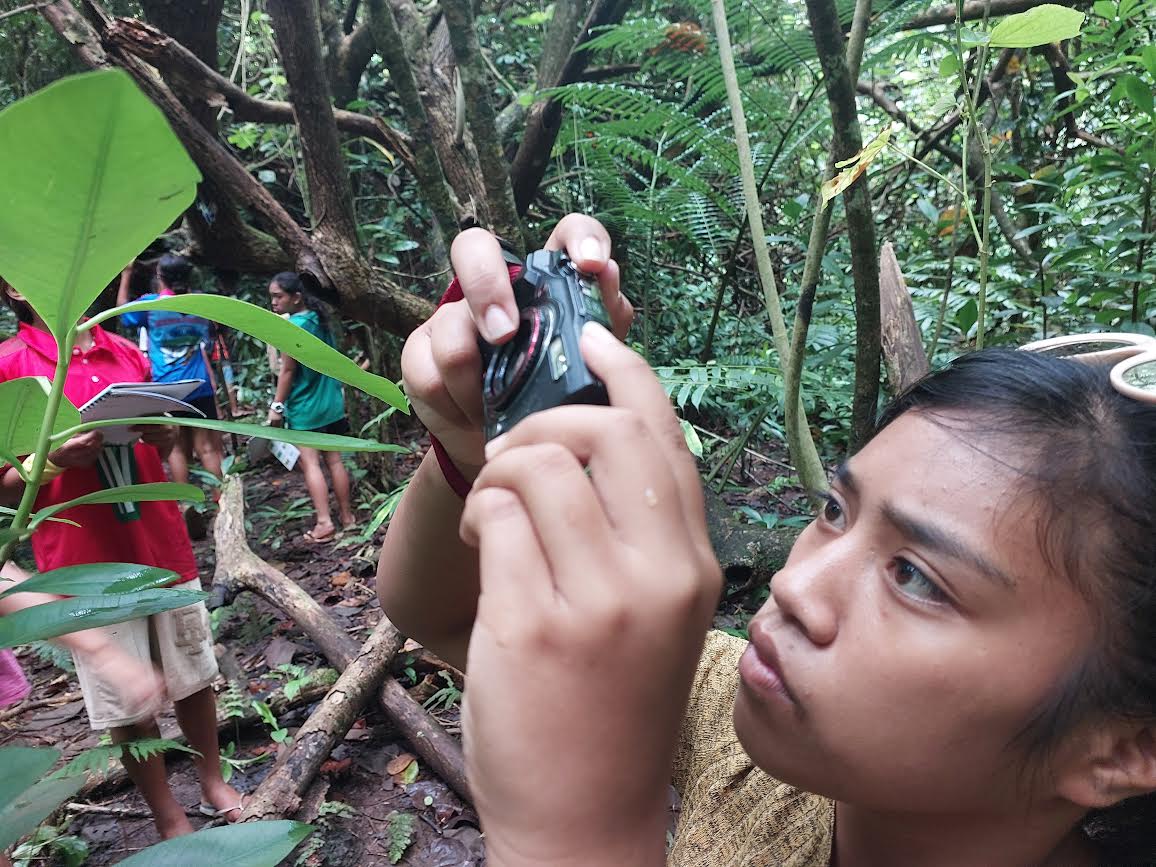Te Ipukarea Society: Securing our future through ongoing environmental education of our youth
Saturday 14 October 2023 | Written by Te Ipukarea Society | Published in Environment, National

Maria Mingi representing Atiu carefully photographed the tiny Rarotongan Orb Weaver Spider, local name, Tangaroa vaka. 23101350
It has been a busy school holiday period working alongside the Cook Islands Voyaging Society, Kōrero o te ‘Ōrau and 40 plus senior ‘Ātui’anga ki te Tango and Mata Nātura students from Aitutaki, Mitiaro, Atiu, Mauke, Mangaia and Rarotonga.
The marine-focused educational programme included activities beyond the reef to see how anchored Fish Aggregation Devices (FADs) work for local fishermen.
There are five anchored FADs around Rarotonga, working by attracting smaller fish and bigger pelagic fish which our local fisherman catch.
Drifting FADs used by purse seine fishing vessels targeting Au’opu (Skipjack Tuna) were also discussed.
Drifting FADs made up of mostly non-biodegradable material such as PVC and other plastics have beacons connected to them, sending signals back to purse seine vessels.
These signals alert the boats to the location of the FAD and the amount of fish that have aggregated around them.
There are negative ecological impacts FADs such as catching non target species including juvenile A’ai (Big Eye Tuna) and A’ai (Yellowfin Tuna) which take longer to reach a reproductive age.
Other bycatch that can be attracted by FADs includes endangered sharks and turtles.
These aspects were discussed with the students, as well as the issues around marine litter from FADs on our islands.
This includes hundreds of FADs that wash up on our national park, Suwarrow.
Ideas on recycling the FAD material such as turning the nets into hammocks and beds were creative comments that were shared.
An inshore turtle tracking survey using underwater cameras to take photos was carried out at Avaavaroa passage.
Like our unique fingerprint markings, turtles have unique facial markings which can be used to identify individuals.
Photos of turtles' facial markings were uploaded to a tracking database managed by Te Ipukarea Society.
Observational counts and notes of turtle behaviors and the overall health of the reef were also recorded on underwater slates made from recycled signboards.

For many of the students, it was their first time to see turtles. Both the endangered Onu kai (Green Turtle) and the critically endangered Onu Taratara (Hawksbill Turtle) were seen on the day.
The iNaturalist app, used to record and share biodiversity findings with local and international experts was also introduced to the students.
Terena Koteka-Wiki from the National Environment Service assisted the students in this area.
Getting the students to practice more of their new biodiversity I.D knowledge, as well as using the iNaturalist app, was next on the programme.
We visited Avana Stream, a freshwater ecosystem, where students were able to identify the I’i (Polynesian Chestnut), Au (Tree Hibiscus) and the Utu (Barringtonia Tree).
The Kourā vai (Prawn), Tangaroa vaka (Rarotonga Orb Weaver Spider) and African Amber snail were also observed as well the dengue spreading Namu wearing black and white football socks (Polynesian Mosquito).
Heading towards the coast of Ngatangiia, the Aroko salt marsh site was visited next.
This is a unique site in that it is the last remaining salt marsh site on Rarotonga.
This salt marsh is different from freshwater swamps where we grow taro, as the area is covered by salt water during high tide.
The Aroko salt marsh provides habitat for certain marine species such as the Koiti raukura (Red Fiddler Crab), the Kuriri (Wandering Tattler), Kōtuku (Pacific Reef Heron) and the Mauku Ta’atai (Saltwater Knotgrass) that helps filter out nutrients and provides safe hatchery conditions for lagoon fish species.
The Koiti raukura, which is visible during low tide, also plays a key role in reducing the pollutants entering the lagoon by feeding on micro-organisms and decaying vegetation.
Threats to the Aroko salt marsh include nearby developments, for example, modifying of drainage systems that divert more sediment and nitrogen than usual to the salt marsh site.
Back at the Uritaua House, a debate-style presentation was organised, with the students learning the pros and cons of deep sea mining.
Four groups represented either a mining company, community members, youth groups, or the government. The community group presented as a split decision with half seeing the potential economic benefits mining could bring, improving our health facilities and infrastructure.
The other half of the community group argued that they did not know enough to have an opinion, or were concerned about how mining money would be used, for instance turning Rarotonga into a heavily developed Hawaii, which has lost its culture and resulted in many of the locals unable to afford living on their own islands.
Meanwhile, the youth team were very worried about their future if deep sea mining damaged the ocean that they relied on for so many things.
Te Ipukarea Society was very grateful to be a part of a youth programme working alongside Kōrero o te ‘Ōrau and the Cook Islands Voyaging Society.
We are also grateful to the German Embassy in Wellington for funding these specific biodiversity activities mentioned and hope the programme encourages our youth to be future naturalists of the Cook Islands, or at least much more aware of our fragile environment.
Other supporting partners from our collaborating organizations include Climate Change Cook Islands, the National Environment Service, Nia Tero, Synchronicity Earth, Seventh Generation Fund for Indigenous People, Ministry of Agriculture, GEF SGP, Bank of the Cook Islands, and Vodafone.




































